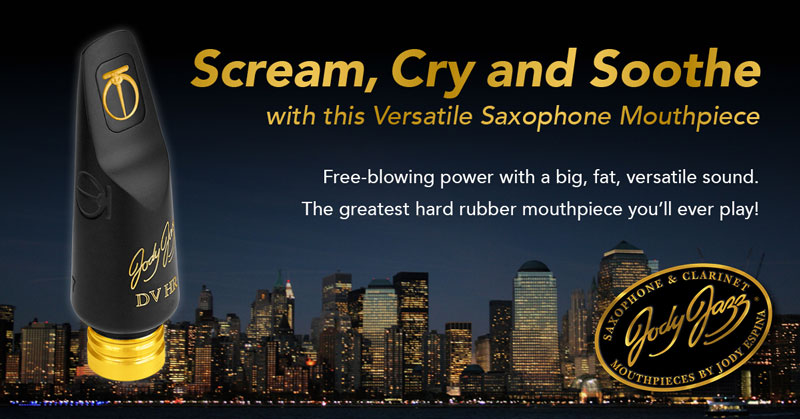Sax Star Chad Lefkowitz-Brown Shares Some Great Musical Advice – and a Cool Arpeggio Exercise
 Official Bio
Official Bio
Chad grew up in Horseheads, a small town in up state New York. His father was a music teacher whose love for jazz naturally flowed into the heart of his young son. With his father as a mentor, Chad had his first saxophone lesson when he was nine years old and so began his musical quest. A year later, he began playing with local jazz legend, George Reed and not long after, when Chad was 11, he won his first DownBeat Magazine Student Music Award. It was evident that Chad had unearthed his niche.
Throughout his teenage years, Chad developed a local following. He began playing throughout his community at clubs, theatres and festivals, and led benefit concerts for local and national homeless shelters and cancer societies. Among the numerous collegiate programs that sought Chad’s scholarship, he continued his education in the arts at the Brubeck Fellowship Program, a prestigious program started by jazz legend Dave Brubeck, in California.
By the time he graduated from the Brubeck Fellowship Program, Chad had won a total of 15 DownBeat awards, including Best Jazz Soloist, and had performed at Carnegie Hall, the GRAMMY Awards, the Monterey Jazz Festival, and many other prestigious venues in North America and Europe. Chad has since moved to New York City where he currently performs and records with many different musical groups throughout New York City and abroad. Most recently, he has recorded as a sideman for Ron McClure (Charles Lloyd/Joe Henderson,) Clarence Penn (Michael Brecker/Dave Douglas,) and Arturo O’Farrill’s GRAMMY winning Afro Latin Jazz Orchestra.
Chad has appeared in concerts with distinguished musicians including Dave Brubeck, McCoy Tyner, Christian McBride, and Josh Groban, and has performed at notable venues such as the Staples Center, the North Sea Jazz Festival, and the Blue Note. Chad is also the musical director and saxophonist for Alice Tan Ridley from America’s Got Talent.
Chad is currently producing his début album “Imagery Manifesto” which takes the listener on a musical journey; one that is unique to each individual.
Zach Sollitto: Why did you choose the saxophone?
Chad Lefkowitz-Brown: I started playing the saxophone when I was 9. I honestly didn’t really like playing sax at first because I didn’t like working out of method books. Since I was homeschooled, my dad, who was a music teacher, had the freedom to show me some things outside of method books. My dad started showing me ways I could improvise, even as a beginner and that sparked my interest.
ZS: Who helped you progress as a saxophonist?
CB: I grew up listening to lots of saxophonists because that’s what my dad played around the house. He was a multi-instrumentalist, but his favorite instrument to listen to was the sax. While I was in high school, I checked out a bunch of books by Jerry Bergonzi and Walt Weiskopf, which helped me get hip to some cool technical stuff to practice. When I went to college, I studied at the Brubeck institute in California. Joe Gilman was the artistic director there and he showed me so much important material. The saxophonists who have helped me progress the most as a musician, whether in person or just through studying there music, have been Donny McCaslin, George Garzone, Jerry Bergonzi, Sonny Rollins and Dexter Gordon.
ZS: Who do you listen to on a daily basis?
CB: I’ve listened to Brad Mehldau a lot the past few years. The way he plays over standards and his approach to writing music has really inspired me. I haven’t checked out sax players much in the recent past, but I think the last saxophonist I was checking out a lot was Donny McCaslin, because I’ve been inspired by his use of wider intervals, which I think gives his playing a sense of freedom.
ZS: What material do you find yourself practicing the most these days?
CB: Technically, I’m focused on using more rhythmic concepts and using triads in every possible way. This thought process comes from George Garzone which teaches you to play every variation of a triad and connecting it to different triads as a way to create tension. I also practice what I like to call diatonic intervallic stacking. For example instead of playing the scale degrees 1,3,5,7,9, I’ll play 1,4,5,7,10,13 and play them as if I was playing any other arpeggio exercise, which I think opens up your ears to different sounds. I’ve found this to be a great way to practice your altissimo range and playing more fluidly in that range instead of hitting a really high note and then jumping back down to the standard fingerings.
ZS: What would you say is the skill or attribute that’s helped you the most as a musician?
CB: I try to focus on doing things in an unconventional way. I try to focus on playing material that is unique to myself. I’ll try to take concepts from other players and make up my own exercises and variations inspired by their ideas to help myself establish a unique approach to playing.
ZS: What’s the single best piece of advice you’ve been given over the course of your playing career?
CB: Really focus on what you love about music and the saxophone. Let that naturally help you approach music. The most genuine musicians play the music they like.
ZS: What’s the next musical frontier for you?
CB: I am going to start touring with Clarence Penn and I’m hoping to continue to play with Arturo O’ Farrill, Ron McClure, and the Metta Quintet. Also, I’m trying to focus more on my solo career since I’ll be releasing my debut album “Imagery Manifesto” this summer.
ZS: What’s your saxophone equipment setup?
CB:
Mouthpieces
- Tenor: I’m probably one of the only saxophone players who have never really liked the Otto Link mouthpieces. I started playing on a Berg Larsen 105/02 hard rubber. The piece was a bit bright but I ended up finding a mouthpiece by Eric Drake while I was going to school in California. I think the mouthpiece plays kind of like a cross between a Berg Larsen and an Otto Link. It’s a 7* opening.
- Alto: On alto I’ve always been happy just playing a Meyer 5.
Saxophones
- Tenor: I used to play on a Selmer Super Balanced Action silver tenor but now play on a Selmer Mark VI 140,xxx tenor.
- Alto: I play on a Selmer mark VI 90,XXX.
- Soprano: I play on a professional model Yanagisawa saxophone.
To learn more about Chad, check out his website at www.ChadLefkowitz-Brown.com.
Chad tearing it up on “Summertime”
Sample of Chad’s new Album






July 8, 2013 @ 5:16 am
Hi…Where is arpeggio exercise?
July 8, 2013 @ 5:30 am
Hey Steve,
It’s not a pdf exercise.
Based on Chad’s advice, you can make up your own exercise based on voicing any type of scale by 1,4,5,7,10,13 instead of 1,3,5,7,9. This is another way to hear different chord tones and see how you can apply theses sounds throughout your solos.
I hope this helps.
Read below for Chad’s description.
Technically, I’m focused on using more rhythmic concepts and using triads in every possible way. This thought process comes from George Garzone which teaches you to play every variation of a triad and connecting it to different triads as a way to create tension. I also practice what I like to call diatonic intervallic stacking. For example instead of playing the scale degrees 1,3,5,7,9, I’ll play 1,4,5,7,10,13 and play them as if I was playing any other arpeggio exercise, which I think opens up your ears to different sounds. I’ve found this to be a great way to practice your altissimo range and playing more fluidly in that range instead of hitting a really high note and then jumping back down to the standard fingerings.
Zach
November 9, 2013 @ 2:01 am
It actually seems more like he was saying that you can stack any series of intervals, whether actually part of a scale or just for building lines, in order to create technical exercises for yourself. A deceptively complex exercise.
January 27, 2016 @ 11:54 am
Hey, I wanted more opinions.I’ve been playing JAZZ on my Alto Selmer super action series 11 for the last 28 yrs.I was just In London and tried the series 111 thought it played like a dream easy in the lows easy in the high high range.Thought I’d love to upgrade.Then I went to a shop in Barcelona where the owner was saying that the Selmer 111 was for classical musicions and tried to sell me a sax whose manafuturer has gone broke.I think he was taking me for a fool. it’s riduclous to think Selmer would market its saxes for classical musicions and as I said that 111 played to well.OPIONONS
January 27, 2016 @ 2:47 pm
Hello Stephen,
I see many players use the Series III for classical music but its a well built horn which could be used for any genre. I would purchase the Series III if it’s significantly better than your current Series II and if not, I would stick with your Series II if it’s in good playing condition and does not have any major dents or wear.
Thanks,
Zach
September 21, 2018 @ 9:19 am
What size brand of reed does Chad use on that 7*?
September 22, 2018 @ 2:08 pm
Hey Aaron,
I believe Chad uses a 2 or 2.5 Lupifaro Classic Cut tenor reeds.